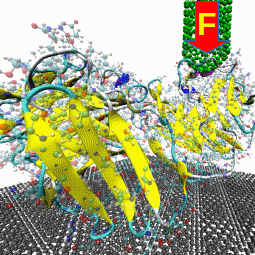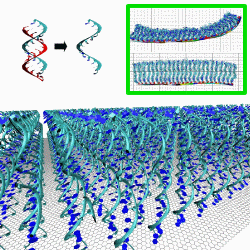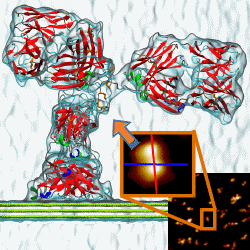SPM-TH
Scanning Probe Microscopy Theory & Nanomechanics GroupForces and Transport in Nanostructures
Research Activities
Multiscale Biophysics: from DNA to Antibodies in their native liquid environment
Significant technical developments in Frequency Modulation (FM) AFM have been required to achieve true atomic resolution in an inorganic surface like mica in a liquid environment. The technique has expanded into the realm of biological imaging, demonstrating unprecedented resolution in the imaging of lipid bilayers, DNA and human antibodies, and the detection of hydration layers. Applications are not restricted to biology and now oxide surfaces that are relevant for technological processes taking place in a liquid environment (like oxide anodes in fuel cells) can also be imaged under more realistic operation conditions. We are now working in this field, using molecular-dynamics (MD) simulations with well-established classical potentials (AMBER), with the aim of understanding both the role of water in the conformation of biological material and its atomic scale characterization with AFM.
Mechanical properties of biological systems.
 |
New AFM operation modes like multi-frequency (MF) AFM, where the cantilever is excited at two of their eigenmodes, have been developed in order to reduce possible damage associated with the forces exerted by the tip on the soft biological samples and to improve the spatial resolution. MF-AFM provides simultaneous access to a topographic image and a map of the local effective elastic properties. We are modelling these experiments with steered molecular dynamics of a tip sampling the IgG antibody (150kDa). Our goal is to understand the connection between the measured effective properties and the real atomistic deformation mechanisms used by the antibody to release the stress created by the tip. Project members: G. Vilhena, R. PérezExternal collaboration: P. A. Serena (ICMM-CSIC), R. García (ICMM-CSIC) |
Hydration properties of Self Assembled Monolayers (SAMs) of single-strand (ss) DNA.
 |
Microcantilever-based biosensors have raised a great interest due to their high sensitivity and low cost. Recent experiments show that changes with the humidity in the effective intermolecular interaction of SAMs of ssDNA grown on top of a cantilever can be used to build a biosensor capable of detecting a single mutation. We plan to work in collaboration with this experimental group in understanding the role played by water in the conformation of these SAMs (height of the individual strands, size of the pore) and the effective interaction of ssDNA. We’ll explore recent measurements that show a marked dependence with the monolayer density (average strand distance) in the SAMs response to changes in hydration. Project members: M. Ortega, J.G. Vilhena, P. Pou, R. PérezExternal collaboration: P. A. Serena (ICMM-CSIC), M. Calleja, J. Tamayo (IMM-CSIC) |
Protein adsorption over surfaces.
 |
The study of protein interaction with material surfaces is a subject of great fundamental and technological interest (e.g. implant surfaces, biosensors, regenerative medicine). Here we apply state-of-the-art molecular dynamics methods to describe at an atomistic level the adsorption of the most abundant plasma proteins (albumin and antibodies) over inorganic hydrophobic surfaces with possible biotechnological applications such as graphene. We have designed a road map to study this process by identifying the main forces governing protein adsorption, setting up more efficient simulation protocols, and proving that implicit solvent methods do not capture the physics of the protein adsorption mechanism. Project members: J.G. Vilhena, R. Pérez.External collaboration: P. Rubio, P. Vellosillo, P. A. Serena (ICMM-CSIC), R. García (ICMM-CSIC) |